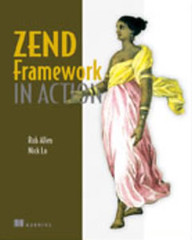Zend Framework in Action Pre-review
 For the last few days I've been reading the MEAP release of Zend Framework in Action from Rob Allen and Nick Lo published by Manning Publications and as a pre-review I d'like to share my reading experience. Currently there are 6 of totally 16 intended chapters available, to find out if them are already worth the money you might want to read further.
For the last few days I've been reading the MEAP release of Zend Framework in Action from Rob Allen and Nick Lo published by Manning Publications and as a pre-review I d'like to share my reading experience. Currently there are 6 of totally 16 intended chapters available, to find out if them are already worth the money you might want to read further.
What's in it?
The first two chapters are introductional and outline what's in the Zend Framework and how it can support and ease the development of (enterprise) web applications. The obligatory Hello World application is used to provide a quick introduction to the MVC pattern and how it's implemented by the framework's controller system and how each part of the MVC pattern is represented in the code artifacts of a application. Next the anatomy of a Zend Framework based application (directory structure, bootstrapping and the request routing to the various components) is layed out to the reader.
After prodviding this 3,000 feet view a community application is introduced, providing the stories and models which will be implemented with the appropriate Zend Framework components and evolve with the coming close-up view chapters. The book carries on to get the guiding application initially going and introduces techniques how to unclutter views through the Two-Step View design pattern and how to build a growing safety-net for your application and it's further evolution via unit tests written in PHPUnit.
The next chapter opens the close-up views by looking at Ajax and how it fits within Zend Framework based applications. The connection of the views to the server/model code is demonstrated first via handcrafted code and next by using two common JavaScript libraries named Prototype and Yahoo! User Interface (YUI). Additional JSON, an important connector in nowadays Ajax application, is covered by taking a look at the Zend_Json component.
Next the focus descends two layers deeper into the model, hosting the specific business logic of an application, by covering the way to establish a connection to the database via the Zend_Db_Adapter and how to perform CRUD actions against it with the Zend_Db_Table component. The linking of tables together is explained by a closer look at the table relationship feature of the Zend_Db_Table component. As a very valuable goodie the authors provide their additional knowledge about testing Zend Framework models.
The last available chapter introduces the concepts of authorisation and authentication and goes on providing the needed theoretical background in addition with explanatory implementations for both scenarios.
Conclusion
As this book is co-authored by Rob Allen, who provides the very valuable introduction I assume everyone getting started with the Zend Framework has used or at least noticed, Zend Framework in Action is the more detailed and naturally matured sequel of it. Though the book isn't released yet the provided knowledge is already valueable whether for novice or more advanced learners/developers whose thirst for knowledge isn't fully covered by the Zend Framework manual. Personally I liked the fact that the authors share their knowledge about unit testing Zend Framework applications and that the reader is guided along an example application, which might motivate to further exploratory coding activities. Reading only these first available chapters leaves you waiting for the rest of it.
1 comment:
Hi Raphael,
Thanks very much for this pre-review; it's a very concise overview of the first bit of the book and I'm glad you are finding the book useful.
If you come across any specific bits that you felt weren't as clear as they could be, feel free to email me directly or post on the MEAP forum.
Regards,
Rob...
Post a Comment